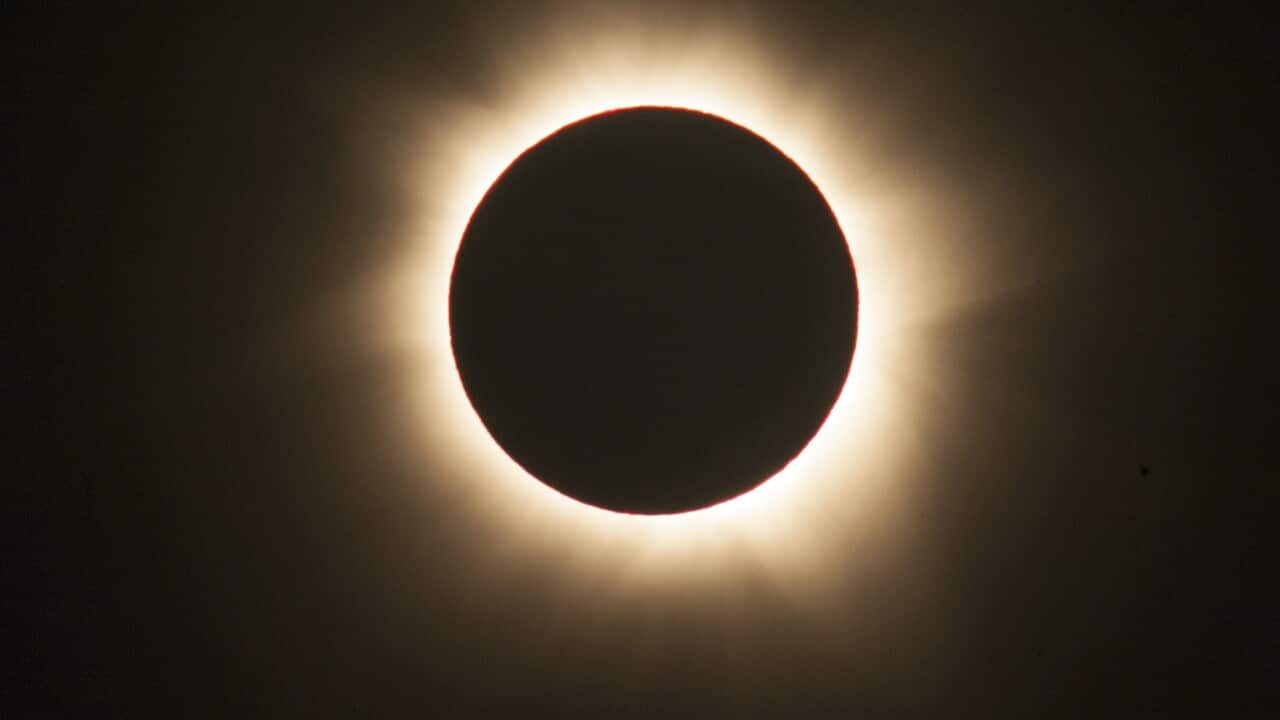A solar eclipse is an awe-inspiring spectacle, but those looking forward to watching the event on Thursday 20 April are being told the safest option is to avoid looking at it directly with their eyes.
The town of Exmouth and the Ningaloo coastal area in Western Australia's northwest will be the best places to be to view the moment the sun and moon align, but Lions Eye Institute ophthalmologist Dr Hessom Razavi said people should avoid looking at the eclipse without taking safety precautions.
“Never ever look directly at an eclipse with the naked eye under any circumstances,” he said.
“If you look at the sun with the naked eye there is a risk of permanently damaging your vision.”
A total solar eclipse happens when the moon passes between the sun and the earth, and has the effect of casting the sky into darkness with only a glimmer of circular light known as the corona or outermost atmosphere of the sun left viewable. During a partial solar eclipse, the moon covers the sun only partially.
On 20 April, Exmouth will be the only place in Australia to experience the total eclipse, with the moon blocking the sun for 58 seconds from 11:29:48am (AWST), according to calculations from the Australian Space Agency. About 40,000 people are expected to descend on the town of about 2,500 for the event.
There is also a 250-kilometre tracking path along the Ningaloo coastal area considered close enough to get a good view of the eclipse in its partial form.
The partial eclipse will run for longer, from 10:04:31am to 1:02:34pm (AWST) and will be visible across the rest of Australia.
In Darwin, 81 per cent of the sun will be covered at 1:52:28pm local time and in Perth, 71 per cent of the sun will be covered at 11:20:30am (AWST). In Sydney, 10 per cent of the sun will be covered by the moon at 2:28:56pm (AEST) and in Melbourne 11 per cent of the sun will be covered at 2:09:05 (AEST).

Where the eclipse is viewable as a percentage of totality. Source: Google / ningalooeclipse.com
People considering watching the eclipse are being advised to adopt a number of safety measures to reduce their risk of exposure to UV light from the sun.
Looking directly at the sun during a solar eclipse can cause permanent loss of vision, the department advises. Children and teens are most vulnerable to solar damage and there is no treatment for it.
Dr Razavi said the sunlight isn’t more dangerous during a solar eclipse, but the event can have the effect of reducing a natural aversion people have to look at it directly.
He added that public interest in observing the event meant there was an increased risk of people suffering eye damage.
“There is a natural interest from the scientific community and the public to witness this rare event,” he said.
“It is an amazing spectacle and it should be viewed safely.”
One option is to use so-called eclipse glasses, which make use of specialised solar filters to protect from eye damage.
People are being encouraged to buy these from a reputable retailer to ensure they meet the which applies to eyewear used for looking directly at the sun.
They are also being advised to check glasses to make sure they aren't damaged or scratched and fit properly.

Eclipse-viewing glasses are an option for people to view the event. Credit: Ian Hitchcock/Getty Images
This can be done through what is commonly known as a pinhole projection technique.
This involves cutting a hole in a piece of paper or make-shift cardboard projector, holding it up to the sky, and allowing the light and shadow of the eclipse to pass through onto the ground or another piece of paper.

People observe a solar eclipse using "pinhole projector" technique. Source: Anadolu / via Getty Images
Other options for people to watch the eclipse include watching live streams or using a telescope with a special solar filter attached.
Experts have also warned against using sunglasses, welding helmets and cameras that don't provide enough eye protection.
The Australian Radiation Protection and Nuclear Safety Agency’s Dr Stuart Henderson said because of the risk of eye damage the body had recommended against any form of direct viewing of the eclipse, even with eclipse glasses.
"Everything has to go right for it to work and we have to weigh that up against potential consequences when we make our recommendation on what to do," he said.
Eclipses only take place a few times every year and when they do occur are only observable from certain unique points in the world.
The only other places the 20 April event will be seen are Timor Leste and the province of Papua in Indonesia.
Astronomy professor Dr Nick Lomb described the event as the "most spectacular" nature has to offer.
“People come from all over the world to see eclipses,” he said.
"It is an awe-inspiring experience - but it is also great being in a group the excitement around you feeds into it."

Eclipse watchers are eagerly anticipating the 20 April event. Source: AAP / Neda Vanovac
"That being said ... it is not long before that sun starts to peak across the moon and that ultraviolet light starts pouring into your retina," he said.
Dr Razavvi said he deemed taking this risk as “unacceptable”, considering most people wouldn’t be in the perfect location.
“You are dealing in seconds here, and not minutes, and particularly for children there is a risk," he said.
Dr Cook said people outside the eclipse's tracking zone should temper their expectations about what they would see.
“It would be like a cloud passing in front of the sun - a temporary dimming,” he said.
“It’s not anything to see [if you’re] not looking at it with solar [eclipse] glasses."










